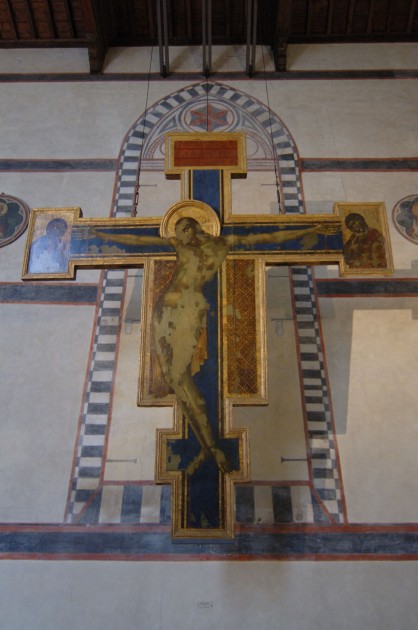Monday, September 28th, 2009
"Dark Water": Florence Flood of 1966
Tonight I finished reading Dark Water (by Robert Clark) as part of Heidenkind’s Art History Challenge. This book focuses on the 1966 flood in Florence which ruined and threatened many works of art. I liked a lot of things in this book, particularly in the middle section where Clark discusses damaged art/books and restoration techniques. I have to admit, though, that Clark’s writing style and half-baked themes about Icarus/water/Ruskin were annoying.
Anyhow, I was most fascinated about how much damage was caused by this flood (which was around 20′ deep in some areas). Clark writes that some 14,000 moveable artworks were damaged or destroyed.1 The Biblioteca Nazionale also suffered extensive damage; 1.3 items needed restorative work and 8 million catalog cards were inundated.2 It was also interesting to read about the innovative things that art/museum directors did to save pieces of history and culture – I particularly enjoyed reading about how the science museum’s director escaped the flood by walking along the roof towards the neighboring Uffizi gallery, while cradling Galileo’s telescope in her arm.
Here are some pictures taken right after the flood (by LIFE photographer David Lees):
 Interior of the Basilica of Santa Croce, 6 November 1966
Interior of the Basilica of Santa Croce, 6 November 1966(Look at all that mud!)
 Moving Paintings in the Piazza Signoria, 6 November 1966
Moving Paintings in the Piazza Signoria, 6 November 1966 Flood Damaged Books, 1966
Flood Damaged Books, 1966
Pretty crazy, huh? Does anyone have any recollections from when this flood occurred?
A large portion of the book discusses the destruction and restoration of Cimabue’s Crucufix from Santa Croce (c. 1288). Water damaged a good portion of the painting, and it took about ten years for the huge piece to be restored (partially because the wooden cross had absorbed so much water). There was a lot of controversy as to whether the cross should be restored at all, since there was so much damage. Ultimately, it was decided that overlapping trateggio (hatching applied with a fine brush) would be placed in the damaged areas, so that the viewer could see the damage but also get a sense of the original composition. I know that some restorers still disagree with how the Crucifix was restored, but it seems to me like the restoration team did a their best, given their limitations.
Here’s a picture of the original crucifix (photographed before 1966):

And here are two post-restoration photographs (the first one is from 1977):
What do you think of the restoration? Do you wish that the area was painted over to give a semblance of Cimabue’s original work, or do you like that the restoration recognizes the damaged areas?
All in all, Dark Water was a pretty interesting book to read. I found the beginning and end of the book to be a little boring, but the bulk of the book was quite fascinating.
1 Robert Clark, Dark Water: Flood and Redemption in the City of Masterpieces (New York: Doubleday, 2008), 162.
2 Ibid., 225.



I think we would all be a little silly to think that every great piece of art is in the state it was when first created. How many pieces of art are treasured and adored that do not have some sort of damage? Time and the elements are not kind, but are unavoidable on this earth. Of course we should try to protect artwork, but shouldn't we also realize and embrace their histories?
I guess what I'm trying to say is I don't mind the restoration. I'm just glad it is intact and able to be viewed and enjoyed.
Sounds like an interesting read. I don't know about the "restoration"–isn't the entire purpose of a restoration to make the pieces as good as new? Anyway, I don't want to criticize it too much because one of my professors worked on that restoration as a graduate student, which I always thought was really cool.
I didn't even know that Florence flooded in 1966. Interesting.
I remember watching a video once (I think in my Asian art class) about a conservator from Europe who went to restore some Buddhist murals in Tibet. Like a true Westerner, this man would only do line drawings of where the original missing parts would have been, since he wanted viewers to know the difference between the original works and his conservation. The Tibetans were really unhappy with his work, though, because what they really wanted was a functional place of worship rather than a historical artifact, so they asked him to fix the murals as they would have looked originally.
Your comments on Cimabue's Crucifix reminded me of that video because on the one hand, as Western culture, we tend to feel the need to preserve the artistic voice–to restore the Crucifix to its original state would seem deceptive in a way since it would no longer be all Cimabue's work. A complete restoration would also hide the fact that the piece has undergone changes throughout history and time. However, on the other hand, the Crucifix was made as a devotional object. Does it still carry the same devotional meaning that Cimabue intended with damage and restoration elements blatantly visible? It's an interesting dilemma.
It's interesting to see the different opinions that readers have on the subject of restoration. (And it's cool that your professor worked on the restoration project, heidenkind!)
Honestly, I can see both sides of the argument. I think Kiersten did a great job of discussing both sides. I tend to like what was done with the Cimabue restoration; since there was so much damage to the cross, a good-as-new restoration would completely lose Cimabue's "hand" in the work.
I also think that Kiersten brought up a good point about devotional objects. I hadn't thought about how the function of Cimabue's cross could be altered (or even lost?) through the current restoration. Then again, in a postmodern world, I'm sure that one could still worship (or, er, have a devotional response?) to the cross. Anyhow, that's a really good point.
I'm sure it's hard for restorers to please everyone. This is a tough subject.
Do you know what I think is really interesting about this flood that damaged/destroyed so many pieces of art? That by damaging/destroying, it also CREATED art. I was just thinking how beautiful those photographs are, particularly the photo of the damaged documents hanging on the racks.
I love the saying, "There's no great loss without some small gain" and it totally applies to this! Out of destruction, new art was born. That's cool.
I like your perspective, e! I totally agree. I also think that some of Lee's photographs are quite striking. I especially like the first photograph I posted, the one of the Madonna surrounded by the mud. I really like the composition and lighting, and I especially like the light and dark highlights caused by the swirls of mud.
It's nice to think about the beautiful things which came out of such a disaster.
Whether or not I would vote for a restoration would completely depend on the future use of the object.
Kind of along the same lines of Kiersten's comment, if the work was hanging in a museum for people to look at, and enjoy the history of…I would not agree with the crucifix being completely restored. Part of its history now includes the flood.
However, as a votive object, I think that you would be honoring Cimabue and his patrons by restoring the work in order for it fulfill its complete purpose.
Either way it is a tough call.
Great comment, phin.
It's interesting to read these comments and think about the Crucifix's intended function and its current one. Cimbue created this cross to hang over the altar at Santa Croce, and it was located there until 1569. At that point, Vasari rebuilt the interior of Santa Croce and sent Cimabue's cross to the refectory of the building (where it would remain for the next four hundred years). So at that point, I would argue that the expressly devotional function of the crucifix was altered. From what I can tell, it seems like the cross became more of a decorative piece for the refectory than a part of a worship (although, granted, I guess it could still be used as a devotional piece while people were dining).
Anyhow, the crucifix was located in the refectory until the 1966 flood. Ironically, if the cross had still been located in the sanctuary of the church, it would not have gotten damaged (or at least not to the same extent) by the flood. After the major restoration, the cross hung in the over the altar for a few days before it was returned back to the refectory (Clark, 251). From what I can tell, the cross is still in the refectory.
So, is it still a devotional image? I'm not sure. And in some ways, the cross has become more of a museum/exhibition piece. In 1982, six years after the cross-hatching restoration was completed, the cross was exhibited in London, New York, Madrid, and Paris.
You can see that the function of this cross has a complex history. Undoubtedly, his complexity ties into the varied opinions about how the cross was/should have been restored. Overall, though, I'm sure that everyone agrees on one point, which kashurst mentioned earlier: it's great that the cross still exists and that it's available for viewing.
Honestly, I can see both sides of the argument. I think Kiersten did a great job of discussing both sides. I tend to like what was done with the Cimabue restoration; since there was so much damage to the cross, a good-as-new restoration would completely lose Cimabue's "hand" in the work.
Water Damage Restoration